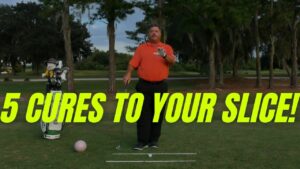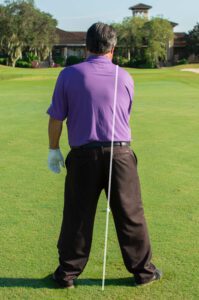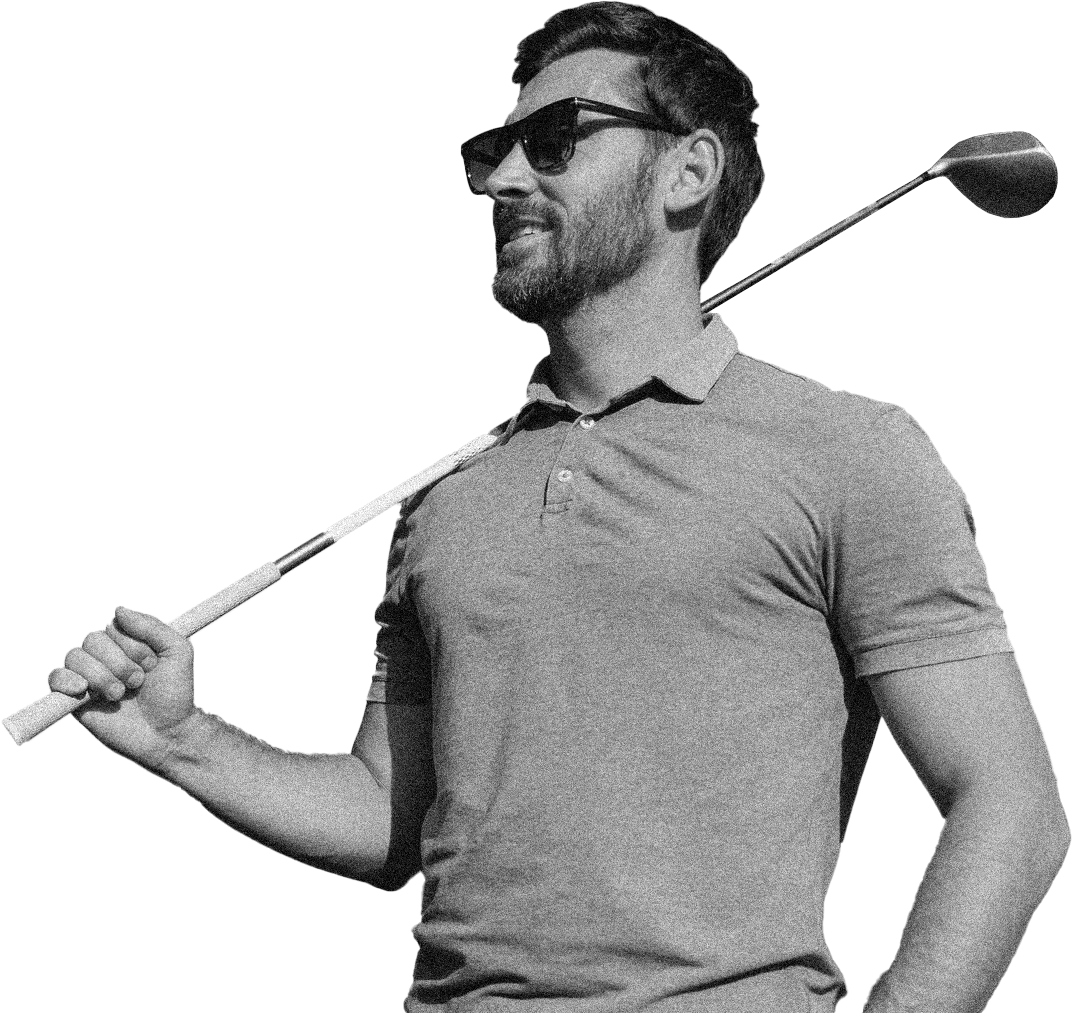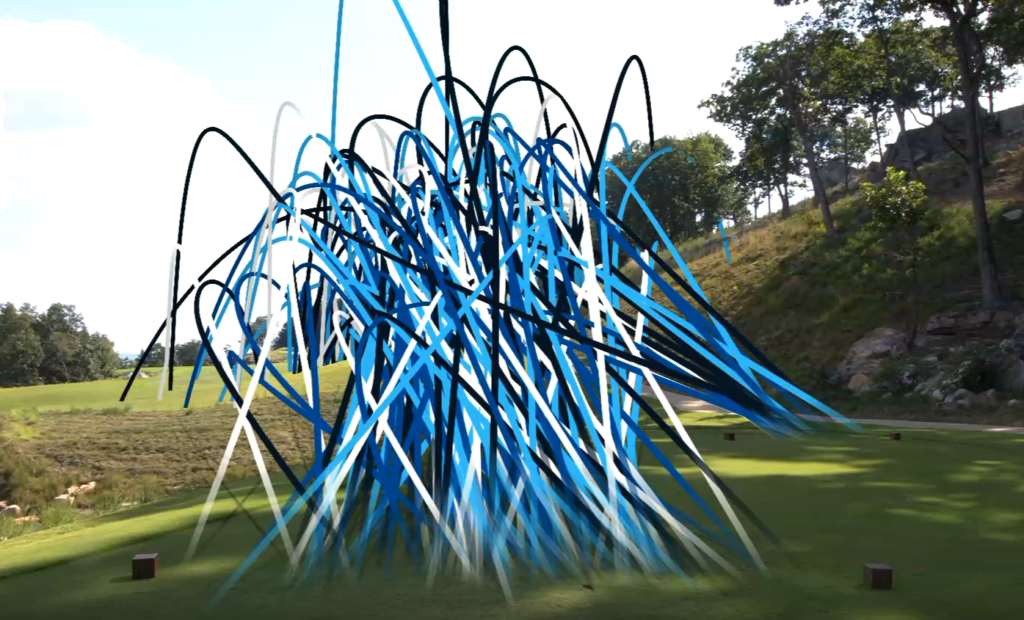I recently had the opportunity to watch both days of a member guest tournament. It was interesting sitting in a golf cart driving the course and watching all the participants have a lot of fun. It was also interesting to watch the frustration and disappointment that some of the participants had in their performance. If only every participant recognized how much better they could have performed if they performed 2 pre-shot tasks better. The first task, aim the club first! The second task, set up to the club!
As Entertaining as the Tournament
Toptracer was present at this event, recording all the tee shots from the 18th hole during the first day of play. In total, there were 148 tee shots attempted that day from that hole, stretched across 3 rounds of 9-hole match play.
When you combine all the shots together into one time-lapse video, it creates what Toptracer calls “fireworks”. The video and final image are fun to watch and view. The image reminds me a lot of a hurricane spaghetti model when you’re trying to predict where the hurricane will be 4-5 days. While it’s entertaining to view the video of all the shots. Watching the video brings up questions you ask me as a golf coach. As well as why is the dispersion of all the shots so wide?
Thank you Toptracer for providing the videos of 148 swings, and the fireworks video!
What are the Questions?
As I viewed all 148 swings, I decided it was best to keep my observations simple and collect 3 data points only.
The first question I asked that became a data point is did the golfer use their club to aim for the shot? Or did they use body?
Second, what was the result of how they aimed? In what direction did they place their body? Were they open, closed, or square to their target.
The last data point in what direction did the ball initially take off to? Did it fly right, left, or straight in relation to where the golfer was intending to aim to.
Viewing all 148 tee shots was just as entertaining as my time spent watching the 2 days of competition. However, watching these videos and collecting the 3 simple data points will shed light for you to understand why amateur golfers struggle to hit their targets. And reach their potential. It also confirms what 1 aspect of your setup is the most vital to execute for each shot, in relation to your ability to hit shots straighter and farther.
Let’s break down the numbers for you to understand how vitally important it is for you to be target fixated, not swing conscious, when you play every shot on the golf course.
What the Documentation Proves
First, I need to state that watching the videos and collecting the data was in no way a formal scientific research project or experiment. For me, spending the time viewing the videos and writing this blog post was more about curiosity killing the cat. As well as what happens in real time as well as what golfers normally do on the golf course.
Combined with the pressure all golfers place upon themselves due to the “importance” of any round, their brains and bodies fell into what make up habitually perform and repeat.
There are numerous studies about how best to aim a golf shot. And most of the research states you must aim the club first. Specifically, the leading edge of the club. And then set your body up to the club. Recent studies also show the relevance to aiming the leading edge of a golf club to a target much closer to the club, within 2-3 feet of where the ball is being played. A closer target allows you to aim the leading edge of the club more efficiently. Resulting you setting up to your club more efficiently. The videos I watched confirm the research.
Data Point #1 – Aiming the Club versus the Body
It was not surprising to me that 85% of the tournament field aimed their body to the target, not the golf club. Within each of those videos, the golfers were more concerned about getting their body in position versus aiming the club first. Whether right-handed or left-handed, most weekend golfers believe that aiming themselves will in turn direct the golf ball to where they ultimately want it to end up.
The golfers who aimed their body first displayed a significantly increased chance of displaying other set up positions that compensated for being aimed improperly. One of the more noticeable compensations
was the relationship between their feet and shoulders. Specifically, their feet being open or closed to the target had a direct correlation to where their shoulders were in relation to their target. Their shoulders were never in line with where their feet were aimed. I call this the “pretzel effect”. Like eating a twisted pretzel, you must unwind yourself first as you take the club away from the golf ball. A compensation in your swing caused by setting up the body first.
Data Point #2 – The Direction of Aim Relative to the Target
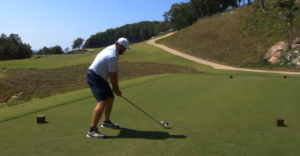
Whether right-handed or left-handed, 79% of the tournament field aimed closed to their target. This is not surprising considering most of the participants aimed their body first.
What was noticeable in the videos was the pre-shot routine of these golfers. None of the golfers stood behind their ball, directly in line with the ball and their intended target. The majority of right-handers show set up closed to their target stood behind the ball to the left side of their extended target line. The opposite was true for left-handers. They stood to the right of their intended target line.
9% who aimed open to their target line. 8 out of the 9 who aimed their body open to their target line created a “pushed” shot to the opposite direction.
Which leaves 12% of the field aiming parallel or square to their chosen target line. In all cases of being parallel to the target line, these golfers used the club to aim with period not their bodies.
Data Point #3 – The Initial Direction of Each Shot
Whether right-handed or left-handed, 53% of all tee shots started right of the chosen target line. 23% started left of the chosen target line. And the balance, 24% started straight at the intended target line.
Diving a little deeper into this very relative data point, Less than 7% of the field who used their club to aim with and then set up their body to the club. All 7% aimed straight to their intended target line. Resulting in all hitting shots that started and stayed on target. I’m not surprised by this statistic.
The findings of my observations viewing the videos is nothing new to me. I witness every day I on the practice facility or on the golf course coaching clients. These findings should be alarming to you!
Some General Observations
It was interesting to watch all 148 shots. What was more interesting was the idiosyncrasies of each participants’ pre-shot routines. Everyone does think differently. And everyone does swing the club differently. Which produced a wide variety of pre-shot routines. How consistent each is with that routine would need to be documented over a longer period. However, the proof is in the pudding. When a correct aiming process is neglected or ignored during any routine, there is a direct correlation to how any golfer will swing the club.
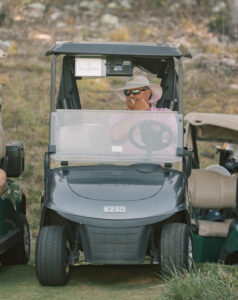
In the case of golfers aiming close to their target, the vast majority had swings that would be labeled over the top. Leaving the club face open with a swing path that’s coming outside in creates a fade. Or worse, slice.
This is a chicken or the egg question. Are the golfers who set up closed actually aware they have an “over-the-top swing”? Or are they setting up to compensate for the over the top? The answer could be both. And without seeing all the golfers swing multiple times it’s hard to assume if they’re compensating or not.
In addition, over 90% of the golfers who aimed closed to their target hit the shot in the direction they were aimed. It wouldn’t matter whether you’re right or left-handed. If you aimed closed to your target, it was almost guaranteed the ball was going to take off in the direction your body was aimed. What should you draw from this conclusion?
That it’s critically important that your body be set up in a direction that allows it to work its most efficient. And it should be set up in relatively the same position with every shot. This one finding should prove to an amateur golfer, without a doubt, that you are inconsistent. You’re inconsistent with your routine of setting up to each shot. Resulting in your inconsistent swings and inconsistent ball flight.
You Have to Do Something Different to Realize a Different Result
Out of the 148 swings I viewed, 1 golfer stood out of the crowd. He recorded 2 swings within 30 seconds of each other. Because he was forced to play a provisional ball.
For his first shot, this right-handed golfer aimed severely closed, or right, of his intended target. His first shot flew on an exact parallel line to which he was aimed; way right! His provisional shot landed in the identical position. Why? Because he set up in the exact same direction he did for his first shot.
It was somewhat comical to watch. But it brings up a subject that most golfers ignore. If you want to see improvement with any skill in golf, you’re going to have to do something different than what you’re doing now.
Critical to the process of learning is your brain’s desire to compare. If you’re doing something different, your brain is now forced to compare. More so about how the body feels relative to what you do normally. We’re talking about setting up differently to create a different result. You cannot compare results until you do something different with your set up.
Because humans are creatures of habit, it’s hard for us to do something different. And we’re forced to be more conscious about how we go about making a difference. Here in lies two critical decisions. One decision is to commit to doing something different. Committing to making the improvement. As well as making the time commitment for the brain to ingrain the improvement. The other decision is to just keep doing the same thing. If you choose this direction, please don’t drive yourself into more frustration thinking by doing the same thing you’ll obtain a different result. Nature just does not work that way.
Conclusion
As I stated previously, this was in no way intended to be scientific study. As much as it is me attempting to prove a point to all golfers. How you aim at a target, for any shot, has a direct correlation to how you swing the club. And in turn, the success of every shot you execute.
The club hits the ball, not you! With every shot, your #1 priority is aiming the leading edge of the club, perpendicular to your intended target line. If your set up routine does not start this way, the chances you’ll hit your target are significantly reduced. You must set up the leading edge of the golf club first. When it is in the correct position and you set up to the golf club, your odds significantly shift in your favor.
And you must resist the temptation to adjust your body to the target because “it doesn’t look right”. You must trust that the leading edge of any golf club. That is in the direction to where you want the ball to start and end up.
As entertaining as it is to watch the tracers crew the fireworks, the explosions going off in your head right now should be to make things much simpler for yourself. Aim the club first and there is a high likelihood there won’t be frustrating fireworks going off as often when you hit your next shot.



